2023.08.01.80
Files > Volume 8 > Vol 8 No 1 2023
Assessment of the variability of the hematological and biochemical parameters in giardiasis patients
1 College of science at the University of Al-Qadisiyah;
* Correspondence: : [email protected]
Available from: http://dx.doi.org/10.21931/RB/2023.08.01.80
ABSTRACT
Giardiasis is one of the essential parasitic intestinal diseases, widespread in many countries. Therefore, it has occupied a necessary place among public health priorities. Children are the most vulnerable and affected by this disease. The current study evaluated the physiological and biochemical hematological changes of affected children under 12 in Al-Diwaniyah Governorate, middle of Iraq. Hemoglobin levels and the volume of compacted blood cells decreased in patients (10.4g/dL and 33.7%, respectively). In contrast, the number of white blood cells increased to (7700 cells/mm3), indicating substantial differences between the hematological parameters and the control group's results.
Regarding the number of cells, the investigation revealed a reduction of (64.1%) in the total number of cells. In contrast to the control data, the results showed a rise in the number of lymphocytes, eosinophils, and basophils, with respective percentages of (%28.4), (%0.6), and (%0.4). Monocytes were unaffected. The findings of the biochemical parameters demonstrated that the concentrations of liver enzymes varied significantly, with the attention of GPT and GOT increasing to(18.7) and (19.9)international units/liter. Additionally, lipid level variations, including lower cholesterol and triglycerides, were discovered. Compared to the control groups, it reached (163.8) and (122.5) mg/DL.
Keywords: Giardiasis, blood parameters, GOT, Giardia lamblia.
INTRODUCTION
Giardia lamblia is a common protozoan that infects humans, especially children, causing steatorrhea1,2. This parasite has two phases during its life cycle. The active phase of the parasite (Trophzoite phase) settles inside the upper small intestine of the host. In contrast, outside the host's body, it remains alive in its Cyst phase, besides temporary phases between the two phases called (Excyzoite) that precede the formation of the Trophozoite phase and the (Excyzoite) that precedes the Cyst phase3. Cyst phases represent the infective stage. They can survive for several months in feces and humid conditions. They can also stay in standard concentrations of chlorine used to sterilize water and are resistant to heat, cold, and drought4,5.
Giardia lamblia is one of the significant causes of diarrhea in children and adults, causing Giardiasis, and its symptoms are acute steatorrhea with dehydration and abdominal pain. The disease most often occurs in children under five years 6. Chronic infection with the parasite may lead to weight loss or delay in growth7; the disease symptoms differ from one person to another and depend on the period of illness, ranging from nausea, vomiting, and flatulence8. Diagnosis of Giardiasis is based on cysts in the stool of infected persons, and Giardiasis can be diagnosed using the ELISA method9. As well as by molecular methods that depend on specific genes in the parasite10. Several studies have focused on the effect of intestinal parasites on blood components, as the researchers showed the occurrence of biochemical changes in the serum of those infected; the current study aims to investigate the effect of the parasite Giardia lamblia on the hematological and biochemical parameters of people with Giardiasis among the different age groups of children infected in Al-Diwaniyah Governorate in the region middle of Iraq.
MATERIALS AND METHODS
Collect samples
The study included collecting 44 blood samples from children with disease from patients who attended the maternity hospital in Al-Diwaniyah Governorate and the hospitals affiliated with the districts and districts of the governorate. At the rate of 3 ml from each child to study the physiological changes caused by this parasite to the infected, 2 ml of it was taken and placed in a normal tube and left in a vertical position for (20-30 minutes). Then it was centrifuged in a centrifuge at 1500 cycles for 10 minutes. The transparent upper part representing the serum was taken precisely using a pipette. The precipitate was neglected, and the serum was sometimes kept in the freezer when the tests were delayed. As for the rest, which is 1 ml, it was placed in tubes for conducting blood tests, in addition to a group of 22 control samples from healthy children of both sexes for the purpose of comparing the results of the tests with them.
Blood tests
Hemoglobin concentration was calculated using the hematology auto-analyzer (Sysmex XTI2000). The volume of compacted pellets was calculated using a Microhaematocrit centrifuge. The total and differential white blood cell counts were calculated using the Impro Neubauer chamber (hemocytometer).
Biochemical examinations
Serum total cholesterol was estimated using (CHOD-PAP Method). The concentration of TG triglycerides in serum was measured using (GPO Method). The aminotransferases GPT and GOT activity was estimated using the Chemistry analyzer Roche.
Statistical analysis
The results were statistically analyzed using the (Least significant differences) (LSD) test using the SPSS23 statistical program under the probability level (P<0.05).
RESULTS
Table (1) shows the results of the hematological parameters of the affected children in the Al-Diwaniyah governorate during the months of the study. The results showed that there were significant differences in the values of the volume of compacted blood cells, the level of hemoglobin, the number of white blood cells and differential white blood cells compared to the results of the control group through statistical analysis and under the level of significance (P<0.05). The study's results showed a decrease in the volume of compacted blood cells and the level of hemoglobin among the affected children compared to the control, which amounted to (7.33%) (10.4) g/dl. Respectively, the lowest decrease in the volume of compacted blood cells was in August, reaching (30%). While the lowest reduction in hemoglobin value was (9.3 g/dL), which was recorded in July
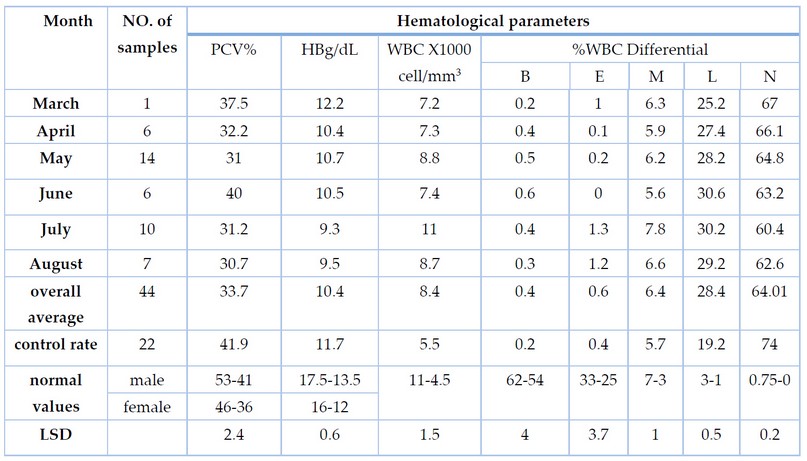
Table 1. Results of the blood parameters of the affected children during the months of the study
Blood changes according to gender
Table 2 shows the results of the hematological parameters of the affected children by sex, where it was found that there were significant differences in the values of the volume of compacted blood cells, hemoglobin level, the number of white blood cells, and white blood cells differential under the LSD level compared to the results of the control group through statistical analysis to test the least significant difference Significant (P<0.05). The results showed a decrease in the values of the volume of compacted blood cells and the hemoglobin level, which reached (33.5%) and (10.2% g/dL), respectively. The results also showed an increase in the number of white blood cells, reaching (8000%) cells/mm in males, more than in females, reaching (8300%) cells/mm in males and in females (7800%) cells/mm. (As for the differential white blood cell values, the value of neutrophils decreased, reaching (65.5%). Its decrease was more in males than females, reaching 64.5% in males) and in females) 66.6%. The values of Lymphocytes, Eosinophil's, and Basophils increased and reached (27.3). %), (0.6%), and (0.3%), respectively, and the values of Lymphocytes and eosinophils in males were higher than in females, while the value of Basophils was higher in females. The values of Lymphocytes, eosinophils and Basophils in males were (28.6%), (0.7%) and (0.2%) and in females (26), (0.6%) and (0.5%), respectively. While the value of single cells was not affected in comparison with the results of the control group, as shown in Table 2.
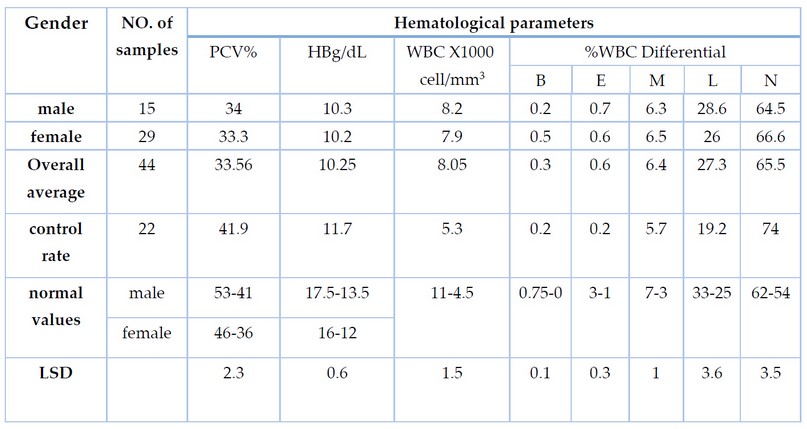
Table 2. The results of the hematological parameters of the affected children by gender
Hematological changes according to age groups.
Table (3) shows the results of the hematological parameters of the affected children according to age groups. There were significant differences in the values of the volume of compacted blood cells, the level of hemoglobin, the number of white blood cells and the differential white blood cells compared to the results of the control group through statistical analysis to test the least significant difference in the level of significance ( P<0.05) The results showed a decrease in the values of both the bound volume of blood cells and the level of hemoglobin. It reached (33.7%) and) (10.3 g/dL), respectively. The age group (6-7) years was the lowest group in terms of a decrease in the values of the volume of compacted blood cells and the hemoglobin level, which amounted to (32%), respectively. The results showed an increase in the number of white blood cells; the largest increase was in the age group (4-5 years), reaching (9500% cells/mm). As for the differential white blood cells, the value of Basophils decreased and amounted to (64.5%), and the group (2-3) years had the lowest decrease in the value of Basophils, which amounted to (63.8%), and the Lymphocyte, Eosinophils and Basophils increased by (26.3%), (0.3%), and (0.5) %) respectively, the group (6-7) years had the highest increase in Lymphocyte value, which reached (30%), and the group (2-3) years had the highest increase in Eosinophil cells. There were no significant changes in the single cells compared to the control group.
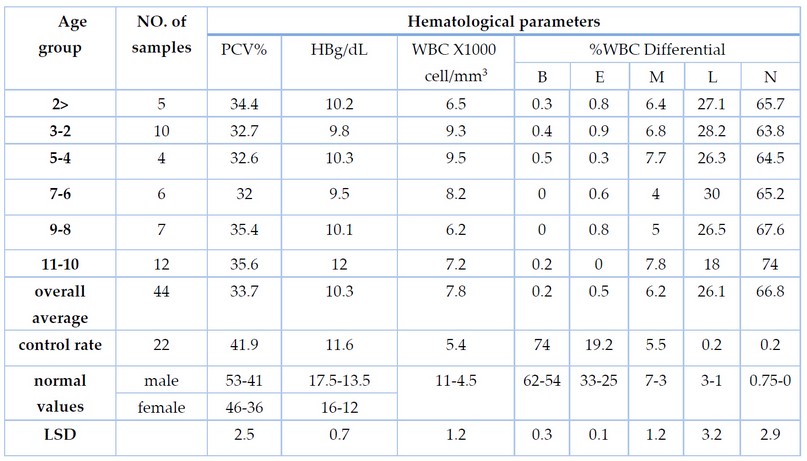
Table 3. Results of hematological parameters of affected children by age groups
Biochemical changes according to the months of study
Table (4) shows the results of the biochemical parameters of the affected children according to months of the study. Significant differences were found in all the biochemical parameters used in comparison with the control group to test the least significant difference in LSD under the level of significance (P<0.05). The results of the study showed an increase in the concentrations of liver enzymes. Amine (GPT and GOT) were (18.7%) and (19.9%) IU/L, respectively, and the highest rise in liver enzyme values was in August, when the results reached (21%) and (24%), respectively. The results reached a decrease in the values of cholesterol and triglycerides (163.8) and (122.5) mg/DL, respectively, and the highest decrease in the value of cholesterol was in July, reaching (154 mg / DL), while the lowest decrease in the value of triglycerides was in August, where it reached (93.4 mg /DL).
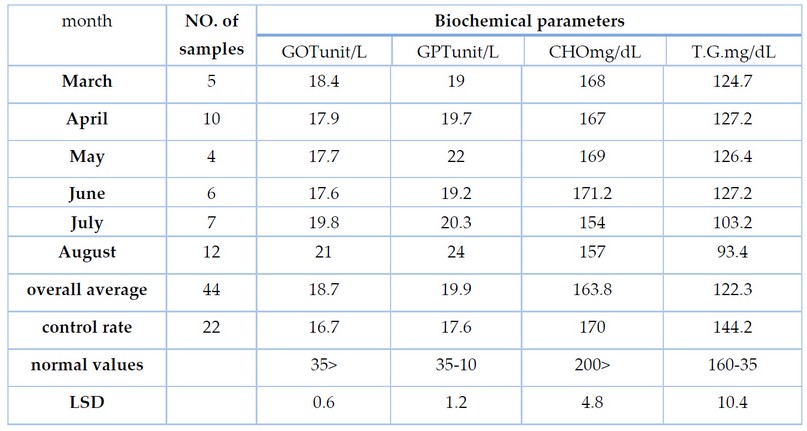
Table 4. Results of biochemical tests for affected children by months of study
Biochemical changes by gender
Table (5) shows the results of the biochemical parameters of children infected with intestinal parasites by sex, where significant differences were found in the biochemical parameters used in all of them by comparing with the results of the control group using the statistical analysis to test the least significant difference under the level of LSD morale (P<0.05). The results showed an increase in the values of liver transaminase enzymes (GPT and GOT), which reached (18.2) and (19.2) IU/L, respectively, and males had higher concentrations of liver enzymes than females, reaching (18.2) and (19.2) in males. IU/L, respectively, and in females (18) and (19.2) IU/L, respectively. The results also showed a decrease in the level of cholesterol and the level of triglycerides, which amounted to (162.6) and (120.5) mg/dL, respectively. The decrease in the level of cholesterol and triglycerides in males was higher than in females, it reached (157.4) and (118) mg/dL in males and (167.9) and (123.1) mg/dL in females, respectively.
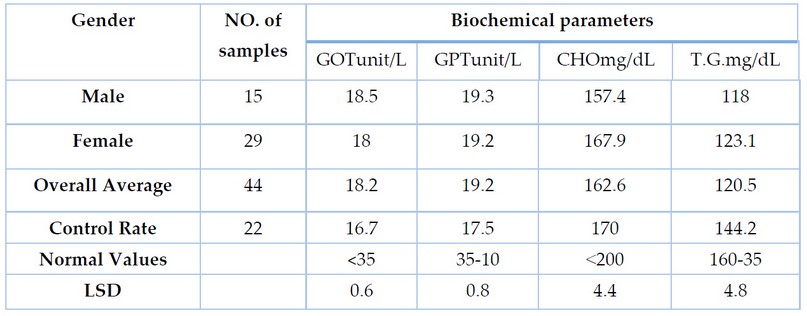
Table 5. Results of biochemical parameters of affected children by gender
Biochemical changes by age groups
Table (6) shows the results of the biochemical parameters of the affected children according to the age groups. We noticed significant differences in all the biochemical parameters used in the current study by comparing them with the results of the control group using statistical analysis to test the least significant difference LSD under the level of significance (P<0.05). The results showed an increase in liver transaminase enzymes (GPT and GOT) compared to the results of the control group, which amounted to (18.5) and (19.1) IU/L, respectively, and the age group (6-7) years recorded the highest increase in enzyme concentrations. , where they reached (20) and (20.4) IU/L, respectively, followed by the age group (4-5 years), which reached (19.5) and (20) IU/L, respectively. The results also showed a decrease in the cholesterol and triglyceride level compared to the control group's results, as the values reached (164.7) and (122.6) mg/dL, respectively. The age group (6-7) years was the most affected by the cholesterol value, reaching (157.5 mg/dL), while the age group (6-7 years) had the lowest decrease in the value of triglycerides, reaching (mg/dL).
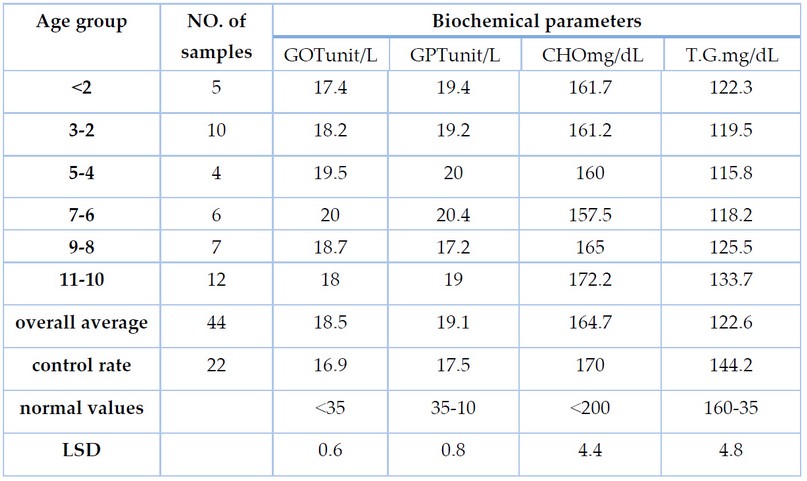
Table 6. Results of biochemical parameters of affected children by age groups
DISCUSSION
The results of the current study showed significant changes in the results of hematological parameters among children infected with intestinal parasites compared to the results of the control group, the level of hemoglobin decreased and the volume of compacted blood cells, while the number of white blood cells increased and amounted to (10.4 g/dl) and (34%) and (7700 cells/mm3), respectively. These results agree with 11, which was conducted to investigate the relationship between parasitic infestation, anemia, and the clinical picture of blood in Wasit Governorate. And12 to find out the effect of pinworm infection on children 12 years old in Kalar city in Sulaymaniyah governorate, which showed that the values of the volume of compacted blood cells and the hemoglobin level were (37.28%) and (12.51 g/dL), respectively. We also agree with 13, conducted in the Dolab village in Babylon Governorate, to find out the effect of hookworm infection on the hemoglobin level of some patients, as they showed the worm caused a significant decrease in the hemoglobin value.
The current study showed changes in the number of white blood cells compared to the results of the control group, where the results showed an increase in the number of cells, eosinophils, basophils, and neutrophils cells, while the monocytes were not affected.14 find out the effect of intestinal parasite infection on some physiological blood parameters showed an increase in the number of lymphocytes, neutrophils, and eosinophil's and a decrease in the number of monocytes, while basophils were not affected. We agree with15, which indicated that the disease - which is responsible for the decrease in hemoglobin and the increase in platelets in the affected children in an area - in India when examining the blood serum of 44 children with the disease. The reason for the low level of hemoglobin and the volume of compacted blood cells may be due to poor absorption of sugars, fats, vitamins, folic acid, zinc, and iron caused by the presence of some parasites in the human intestine. Since iron deficiency causes anemia because it enters the composition of hemoglobin, which is the main component of red blood cells, and the presence of the nutrient phases that stick to the villi of the intestine and absorb quantities of blood, as well as the hemolytic factors produced by parasites and other factors contribute to the occurrence of cases anemia16.17. As for the rise in white blood cells and some differential white blood cells, it may be due to the strong response of the immune system to confront and eliminate parasites. Parasites inside the body, then these cells attach to surfaces and begin to remove their granules, then attack the parasites and kill them18.
The changes in the level of cholesterol and triglycerides differences were found in all parameters. The results showed an increase in the concentrations of liver enzymes GOT and GPT, which reached (18.7) and (19.9) IU/liter, respectively. Biochemical parameters, where it was confirmed that there was an increase in the values of the three liver enzymes GOT, GPT, and ALP, which reached (25.2), (14.4), and (41) IU/L, respectively. The increase in GOT and GPT enzymes may be because some parasites, such as Giardia, cause diarrhea that leads to poor absorption and digestion19. The energy in food is not used correctly, and therefore, the energy stored in the liver is resorted to, which causes an increase in the level of these enzymes to compensate for it20. The level of cholesterol and triglycerides also decreased, reaching (163.8) and (122.5) mg /DL, respectively, and these results agree with21 with their study of the effect of Giardia infection on some biochemical parameters in Kirkuk governorate, where they showed a decrease in cholesterol, which reached (143 mg / DL). We also agree with22 those who showed a significant decrease (P<0.05) in the number of WPS and platelets in patients with Giardiasis in Najaf Governorate, and they also showed a significant decrease in the values of RBS, MCHC, MCH, and PCV in comparison with the control group.
The effect of parasites on lipids, and despite the occurrence of changes in the level of lipids is not completely clear, the signs leading to these changes are not understood. Because of the lack of studies related to this, parasites may have a role in inducing these changes, especially in severe infections with parasites. Cholesterol also has an important role in the parasite's pathogenesis, as it keeps it in the trophic phase, and therefore the lack of cholesterol makes the parasite enter the cyst phase that causes infection23.
CONCLUSIONS
Giardiasis has a significant effect on the level of hematological and biochemical parameters with a clear significant difference in the affected patients, which shows the need to manage the disease in terms of treatment and control to prevent the development of the disease in children and, consequently its effect on the bodily systems, causing weakness in growth and some physical imbalances.
Funding: This research received no external funding.
Acknowledgments: Thanks to the Microbiology Laboratory - Department of Environment staff at the College of Science at the University of Al-Qadisiyah for their help in completing the tests for this research.
Conflicts of Interest:
There is no.
REFERENCES
1.
2. Gilf. F., VenturaL. L. A., FonsecaJ. F., Saniago H. C., BusattiH., Santos J. F. G.; Gomes, M. A. Hematological profile in natural progression of Giardiasis: kinetics of experimental infection in gerbils. The Journal of Infection in Developing Countries 2018, 12(06), 492-498. https://doi.org/10.3855/jidc.9626
3. Łanocha, A.; Łanocha-Arendarczyk, N.; Wilczy ´nska, D.; Zdziarska, B.; Kosik-Bogacka, D. Protozoan Intestinal Parasitic Infection in Patients with Hematological Malignancies. J. Clin. Med. 2022, 11, 2847. https://doi.org/10.3390/jcm11102847
4. Ringqvist, E.; Troell, K. and Svärd, S. Transcriptional changes in Giardia during host-parasite interactions. Int J Parasitol. 2011, 41 (3-4):277-85. https://doi.org/10.1016/j.ijpara.2010.09.011
5. Ensink, JH.; Vander, HW. and Amerasinghe, FP. Giardia duedenalis infection and wastewater irrigation in Pakistan. Trans. Soc. Trop. Med, Hyg. 2011, 100: 538-542. https://doi.org/10.1016/j.trstmh.2005.08.014
6. Maysaloon W. Ibraheem, Abdulkhaliq A. Farhan, Sataa M. Salih, Th.T. Mohammed. Carcass characteristics of Awwasi lambs supplemented with Selenium and Vitamin D3. Iranian Journal of Ichthyology.2022, Vol 9, No. 1, pp: 355-359. Thompson, RC. The zoonotic significance and molecular epidemiology of Giardia and Giardiasis. Vet Parasitol, 2004, 126:15-35. https://doi.org/10.1016/j.vetpar.2004.09.008
7. Hobi, A. A. .; AL-Helal, A. . Effect Of Alcoholic Extract Of Opuntia Ficus Indica On Semen Quality Of Awassi Rams After Different Cooling Periods. ). Journal of Life Science and Applied Research. 2021, 2, 9-13
8. Panaro, M. A.; Cianciulli, A.; Mitolo, V.; Mitolo, C. I.; Acquafredda, A.; Brandonisio, O. and Cavallo, P. Caspase-dependent apoptosis of the HCT-8 epithelial cell line induced by the parasite Giardia intestinalis. FEMS Immunol Med Microbiol.2007.
9. Ratner, D. M.; Cui, J.; Steffen, M.; Moore, L. L.; Robbins, P. W. and Samuelson, J. Changes in the N-glycome, glycoproteins with Asn-linked glycans of Giardia lamblia with differentiation from trophozoites to cysts. Eukaryot Cell. 2008, 7:1930-1940. https://doi.org/10.1128/ec.00268-08
10. Hooshyar H, Rostamkhani P, Arbabi M, Delavari M. Giardia lamblia infection: a review of current diagnostic strategies. Gastroenterol Hepatol Bed Bench. Winter; 2019,12(1):3-12. https://pubmed.ncbi.nlm.nih.gov/30949313
11. Ibraheem M W, Muhaimeed A R, Mohammed Th. T. Leg cuts from Awaasi lambs fed a diet with varying levels of Rhus coriaria L., Physical dissection and chemical composition. Revis Bionatura 2022;7(4) 4. http://dx.doi.org/10.21931/RB/2022.07.04.4.
12. Kadir, Mohammed A.; Mohammad-Ali, Sirwan M. Nutritional status of children infected with Giardia lamblia and Entamoeba histolytica infections in Kalar town, Iraq. Tikrit Journal of Pharmaceutical Sciences 2011, 7 (2):162-170.
13. Mansour, Mohamed Emad; Abd al-Abbas, Salim Khudair and Haider, Harith Rajab. The effect of worm Ancylostoma doudenale infestation On the hemoglobin level of some patients in the village of Dolab / Al-Kufa University Journal of Life Sciences, 2009, 1(2):181-185.
14. Adday, Lika'. Hematological test in patients with intestinal parasites in Al-Hashimiah village. Al-Kufa University Journal for Biology 2009, 1(1):145-148. https://www.iasj.net/iasj/download/7df56e30ee2c7b27
15. Abdullah,I., Tak,T. and Ahmad, F. Impact of Giardiasis on Hematological Profile of Infected Children. Journal of Medical Sciences 2017, 17: 140-143. DOI: 10.3923/jms.2017.140.143
16. Suwaid, A. H. .; Rashid, M. A. .; Taha, M. M. . Genetic Analysis For Combining Ability And Estimation Of Some Genetic Parameters Of Yield And Its Components In Maize Using Half Diallel Cross. ). Journal of Life Science and Applied Research. 2020, 1, 60-64.
17. Cantos, GA; Dutra, RL.; Koerich, JPK .Ocorrência de Anemia Ferropriva em Pacientes com Enteroparasitoses. Saúde em Revista. 2004,10:43-
18. Al-Jebory, K. Abdul-Hussien. Effect of Giardia on some biochemical variables in human blood serum. Al-Mustansiriyah Journal for Pharmaceutical Sciences 2005, 2(1):29-35. https://www.iasj.net/iasj/article/29472
19. Behrman, RE. Nellson textbook of pediatrics 14th ed.; Saunders, London, 1992, pp.449.
20. Maysaloon W. Ibraheem, Abdulkhaliq A. Farhan, Sataa M. Salih, Th. T. Mohammed. Carcass characteristics of Awwasi lambs supplemented with Selenium and Vitamin D3. Iranian Journal of Ichthyology 2022, 9(1): 355-359.
21. Yahya, G. S.; Esraa, A. M. and Majida, N. I. Effect of Giardia lamblia on some biochemical changes of the human. Tikrit Journal of Pure Science 2007, 12 (1):29-32. https://iasj.net/iasj/download/77faf1c24ccd3d12
22. Taher, H., N. Hattoof, J.; Khdayer, A. Hematological changes in patients infected with Giardiasis In Al-Najaf province. Al-Kufa University Journal for Biology, 2020, 12(1). Retrieved from https://journal.uokufa.edu.iq/index.php/ajb/article/view/8151
23. Bansal, Devendra; Harinderpal, Singh Bhatti and Rakesh, Sehgal. Role of cholesterol in parasitic infections. BioMed Central Ltd. Lipids in Health and Disease, 2005, 4:10. https://doi.org/10.1186/1476-511X-4-10
24.
Received: January 15, 2023 / Accepted: February 25, 2023 / Published:15 March 2023
Citation: Al-Abodi, H. R. Estimation of variability in hematological and biochemical parameters of patients with Giardiasis. Revis Bionatura 2023;8 (1) 80. http://dx.doi.org/10.21931/RB/2023.08.01.80
